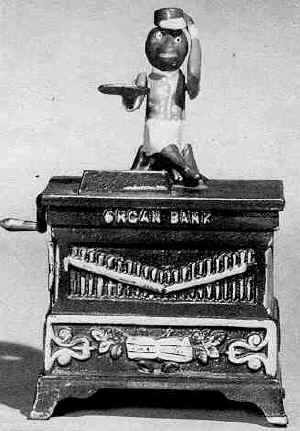Organ Bank
by F.H. Griffith - HOBBIES Magazine - June, 1979
 The
May 1979 article mentioned that animals were a popular subject matter for the designers
and manufacturers of mechanical banks. Many kinds of animals are represented by the
mechanicals, including lions, bears, dogs, elephants, pigs, buffalo, tiger, camel, horses,
mules, cats, squirrel, rabbits, wolf, cow, ram, bull, and last, but not least, monkeys.
Monkeys form a rather sizeable group of the mechanical banks, and these include from
common to rare and simple action to more complicated action. Some of the mechanical banks
in the monkey group are Monkey And Coconut, Monkey And Parrot, Rival (a very rare bank),
Monkey With Tray, Zoo, Monkey Bank, Monkey (Coin in Stomach), Little Jocko Musical, Lion
And Two Monkeys, Chimpanzee Bank, Hall’s Excelsior, Give Me A Penny, and the four
different Organ Banks.
The
May 1979 article mentioned that animals were a popular subject matter for the designers
and manufacturers of mechanical banks. Many kinds of animals are represented by the
mechanicals, including lions, bears, dogs, elephants, pigs, buffalo, tiger, camel, horses,
mules, cats, squirrel, rabbits, wolf, cow, ram, bull, and last, but not least, monkeys.
Monkeys form a rather sizeable group of the mechanical banks, and these include from
common to rare and simple action to more complicated action. Some of the mechanical banks
in the monkey group are Monkey And Coconut, Monkey And Parrot, Rival (a very rare bank),
Monkey With Tray, Zoo, Monkey Bank, Monkey (Coin in Stomach), Little Jocko Musical, Lion
And Two Monkeys, Chimpanzee Bank, Hall’s Excelsior, Give Me A Penny, and the four
different Organ Banks.
A popular figure on the American scene in the late 1800’s and early 1900’s was the organ grinder with his ever active monkey going through his antics to the tunes of the organ. So it is quite logical that this subject matter is well represented in the monkey group of the mechanicals. These include the four Organ Banks — Organ Bank (Cat And Dog) Type I, Organ Bank (Boy And Girl) Type II, Organ Bank (Miniature), and the Organ Bank (Monkey). The first three of these have already been classified in past articles, and it is the fourth one, Organ Bank (Monkey), that we now concern ourselves with as No. 277 in the numerical classification.
The Organ Bank (Monkey) was patented May 31, 1881, by Louis Kyser and Alfred C. Rex, of Philadelphia, Pennsylvania, and made by their concern, Kyser & Rex, of the same city. The patent papers and drawings are identical to the bank with one exception. Instead of bells as used on all their Organ Banks, a comb similar to those in some music boxes was to be utilized to provide the musical sound. The patent refers to the comb as a ‘musical fork’ and further explains that they do not confine themselves to this method of providing music, but prefer this method for this type of toy. The writer feels that when the bank approached the production stage they, Kyser & Rex, decided to use bells. The writer has never seen or heard of any of the four Organ Banks that used a comb or fork for providing the sound. He feels quite certain that none were ever produced in this fashion.
The bank shown is in excellent original condition with no repairs and fine original paint. Colors are an all over brown on the organ with the name, pipes, and decorations on the front in gold. The music sheet on the lower front section is white with black notes. The grillwork on the sides and the back is in gold, as is the crank operating handle. Inscribed in the back is the patent date ‘PAT. MAY 31, 1881’. The monkey sits on a green seat and he has red trousers and a yellow jacket. The jacket has red edging, red buttons, and white cuffs. His hat is blue with a yellow visor and a yellow dot on top. The monkey is brown with white eyes, black pupils, and a red mouth. The extended tray in his right hand is gold. This all adds up to a very attractive bank.
The bank is held together by a large force bolt through the center top and bottom. A key lock coin trap is in the base plate.
To operate, a coin is placed on the tray and the crank on the right side is turned clockwise. This causes the monkey to lower the tray to the raised edge coin slot where it slides from the tray into the bank. At the same time he tips his hat forward and then back to his head as shown in the picture. The bells inside make a pleasant sound accompanying the described action.
In closing, when we mention the different animals in the first paragraph some are plural and some singular. These that are singular are mechanical banks which exist in the one animal form only, to the best of the writer’s knowledge.
